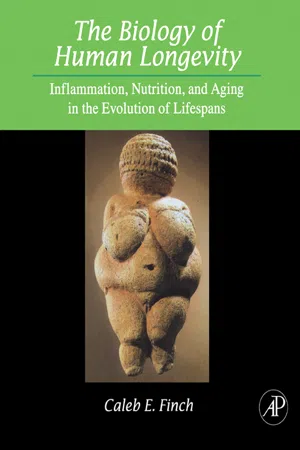
The Biology of Human Longevity
Inflammation, Nutrition, and Aging in the Evolution of Lifespans
- 640 pages
- English
- ePUB (mobile friendly)
- Available on iOS & Android
The Biology of Human Longevity
Inflammation, Nutrition, and Aging in the Evolution of Lifespans
About This Book
Written by Caleb Finch, one of the leading scientists of our time, The Biology of Human Longevity: Inflammation, Nutrition, and Aging in the Evolution of Lifespans synthesizes several decades of top research on the topic of human aging and longevity particularly on the recent theories of inflammation and its effects on human health. The book expands a number of existing major theories, including the Barker theory of fetal origins of adult disease to consider the role of inflammation and Harmon's free radical theory of aging to include inflammatory damage. Future increases in lifespan are challenged by the obesity epidemic and spreading global infections which may reverse the gains made in lowering inflammatory exposure. This timely and topical book will be of interest to anyone studying aging from any scientific angle.
- Author Caleb Finch is a highly influential and respected scientist, ranked in the top half of the 1% most cited scientists
- Provides a novel synthesis of existing ideas about the biology of longevity and aging
- Incorporates important research findings from several disciplines, including Gerontology, Genomics, Neuroscience, Immunology, Nutrition
Frequently asked questions
Information
Inflammation and Oxidation in Aging and Chronic Diseases
Publisher Summary
PART I
1.1 OVERVIEW

Table of contents
- Cover image
- Title page
- Table of Contents
- PREFACE
- ACKNOWLEDGMENTS
- Chapter 1: Inflammation and Oxidation in Aging and Chronic Diseases
- Chapter 2: Infections, Inflammogens, and Drugs
- Chapter 3: Energy Balance, Inflammation, and Aging
- Chapter 4: Nutrition and Infection in the Developmental Influences on Aging
- Chapter 5: Genetics
- Chapter 6: The Human Life Span: Present, Past, and Future
- BIBLIOGRAPHY
- NAME INDEX
- SUBJECT INDEX